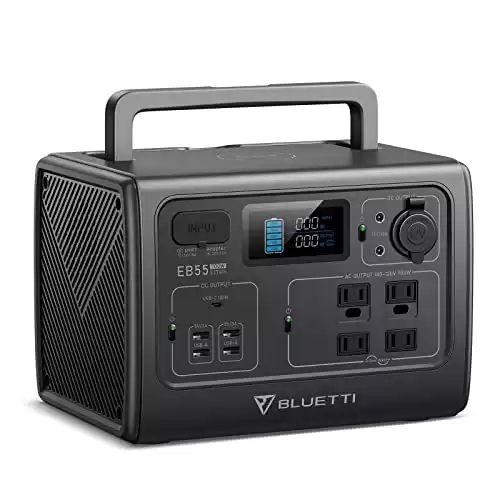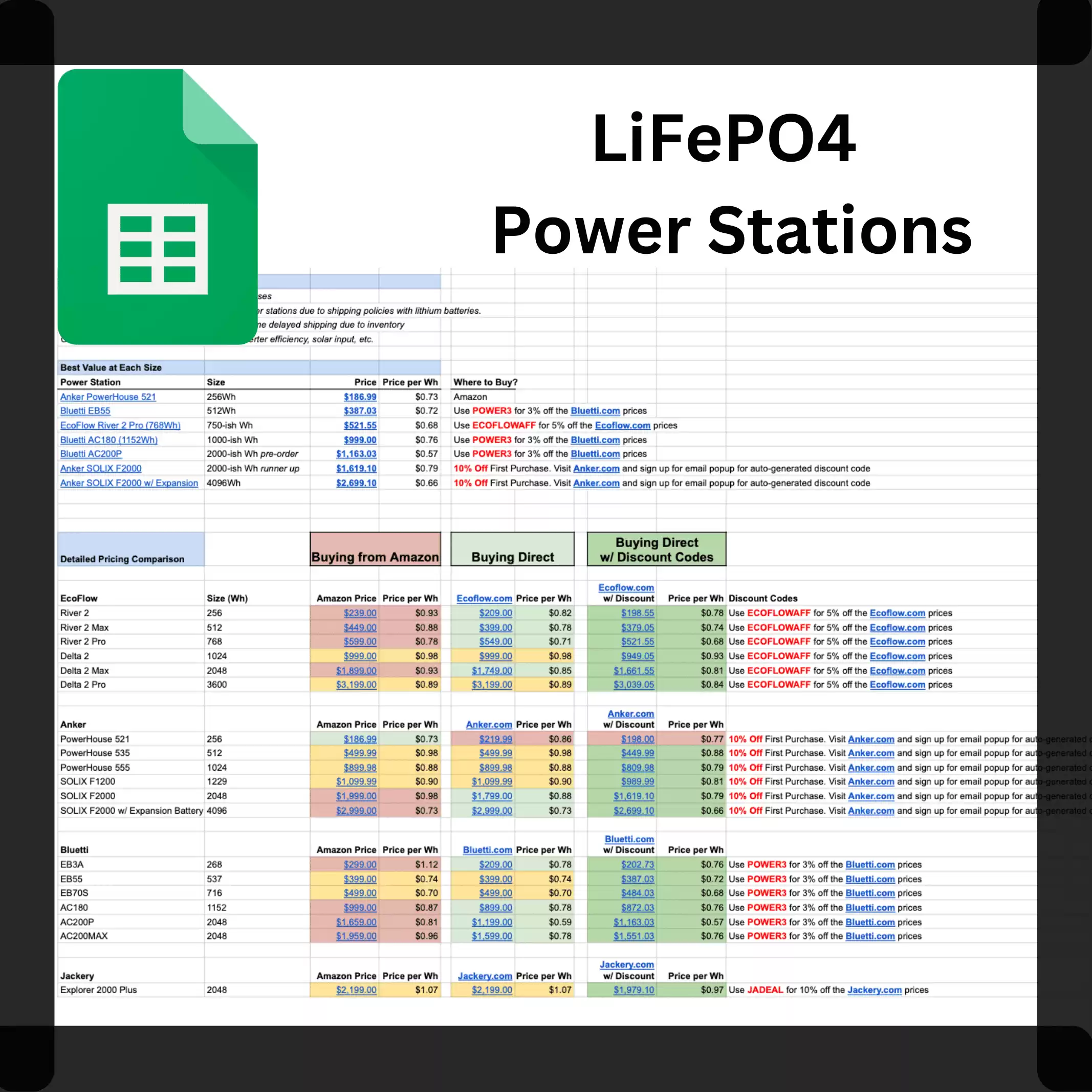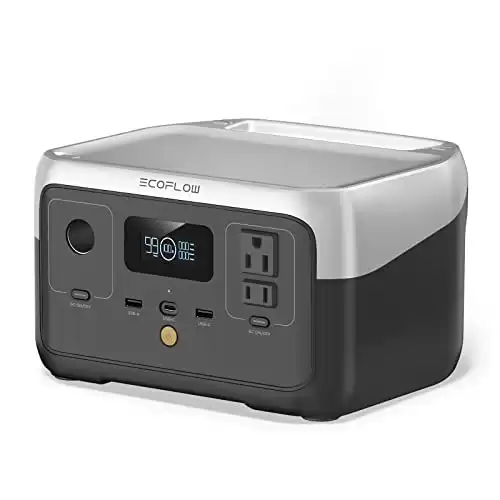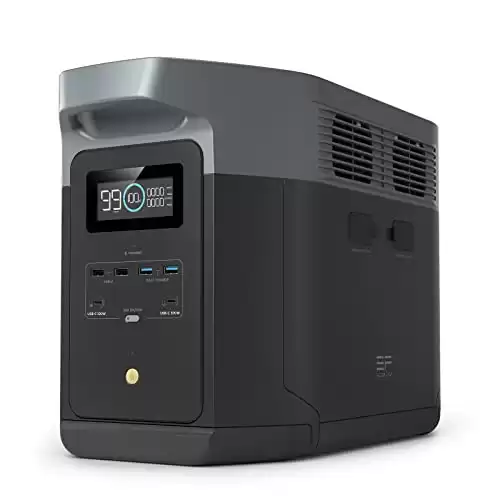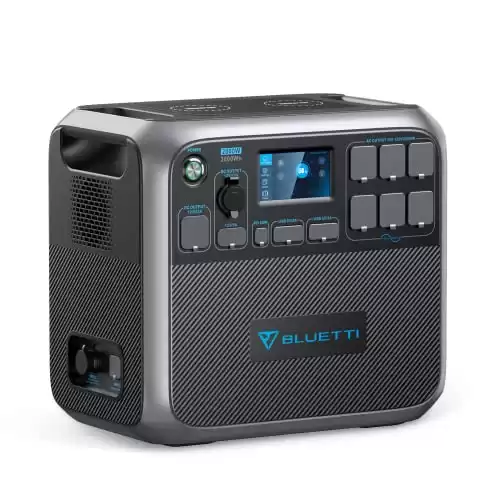Alright folks, below are some of the top portable power stations on the market.
You can also use my portable power station tool to filter and compare to find the best portable power station for your specific needs.
The top power stations for camping, home backup, and emergency preparedness (prepping) are designed for durability, long-lasting performance, and ease of use.

Why Read? Other top articles on portable power stations, like the New York Times, do not differentiate between LiFePO4 and NMC batteries, a main decision factor in choosing the best portable power station.
And just to clear the air: I’m not in anyone’s pocket. No sponsorships, no freebies, no special deals. Clicking through my links earns me a small amount and supports the site. Thanks for considering them! 🙏
This comprehensive guide in portable power stations includes:
- Best Portable Power Stations – updated for 2023
- Choosing the Best Portable Power Station
- Categories, important factors, etc
- How Portable Power Stations are Tested
- Power Station Comparison Tool – search and compare
- Portable Power Stations Trends 2023 and Beyond
- Power Station Summary and Spreadsheet
Best Portable Power Stations
Buying a quality portable power station is essential. While cheap options on Amazon may be tempting, remember not all are tested for reliability or safety.
Bob from his mom’s basement can slap a label on it and send it to Amazon without ever turning it on, let alone testing it.

I recommend buying from the top portable power station brands such as Ecoflow, Bluetti, Jackery, and Anker. Each brand has years of industry experience, vast sales, and solid reviews. Plus, their customer service typically delivers a great experience.
In addition, I recommend LiFePO4 Power Stations (more on that later).
N/A | $529.00 | N/A | N/A | ||||
Description: The Anker 521 is a small portable power station with LiFePO4 power station, making it a better option over Jackery and it's typically cheaper than EcoFlow and Bluetti's option. | Description: The Bluetti EB55 is one of the most popular portable power stations. It's reliable and budget-friendly. It uses LiFePO4 battery technology, which means it will last up to 6 times longer than the popular Jackery 500. | Description: The EcoFlow River 2 Pro is the best power station campers. It allows the entire family to charge their gadgets for a weekend and have room to spare. For remote working, it can power your setup for days and you can charge it quickly on the go. | Description: Very similar to the EcoFlow River 2 Pro and can sometimes be cheaper depending on current discounts and sales. | Description: The EcoFlow Delta 2 is best power station in the 1000Wh range, easily beating the most popular Jackery Explorer 1000. The EcoFlow Delta 2 is not only cheaper, but it uses better battery technology (LiFePO4). | Description: In the 2000Wh capacity range, Bluetti typically has the best prices and specs. | Description: Anker has one of the best deals for power stations for home backup. The Anker Solix 2000 is expandable, meaning you can add capacity to it and upgrade it as your needs change. | Description: Key Takeaways
|
The Anker 521 is a small portable power station with LiFePO4 power station, making it a better option over Jackery and it's typically cheaper than EcoFlow and Bluetti's option.
The Bluetti EB55 is one of the most popular portable power stations.
It's reliable and budget-friendly. It uses LiFePO4 battery technology, which means it will last up to 6 times longer than the popular Jackery 500.
The EcoFlow River 2 Pro is the best power station campers. It allows the entire family to charge their gadgets for a weekend and have room to spare.
For remote working, it can power your setup for days and you can charge it quickly on the go.
Very similar to the EcoFlow River 2 Pro and can sometimes be cheaper depending on current discounts and sales.
The EcoFlow Delta 2 is best power station in the 1000Wh range, easily beating the most popular Jackery Explorer 1000.
The EcoFlow Delta 2 is not only cheaper, but it uses better battery technology (LiFePO4).
In the 2000Wh capacity range, Bluetti typically has the best prices and specs.
Anker has one of the best deals for power stations for home backup. The Anker Solix 2000 is expandable, meaning you can add capacity to it and upgrade it as your needs change.
Key Takeaways
- Amazon is more expensive for most power stations
- Save $$$ with discount codes I find
EcoFlow Portable Power Stations
Ecoflow has become the leader in portable power stations. With 1,000s of reviews on Amazon (compared to 100 or fewer on newer entrants), they have been innovating and growing quickly.
Ecoflow sells everything from small 256Wh portable power stations to enormous 7200Wh Home Battery Backup Solutions.
They sell power stations with both LiFePO4 and NMC batteries. The product names with “2” in it are LiFePO4 (ie: Delta 2, Delta Max 2, River 2, etc).
A standard 5-year warranty is attached to their LiFePO4 power stations.
Below are the best Ecoflow Power Stations (with LiFePO4) for various situations.
- The EcoFlow River 2 is great for 1 or 2 people on a casual weekend trip.
- Best for family weekend trips for charging multiple devices for several people.
- Great power station for powering larger gear like drones, cameras, laptops, etc.
- This is the size I use (with 2x 100W solar panels) for working off the grid.
- Powers 90% of appliances (1800W output)
- Expandable to 3000W with extra battery
- The Delta 2 Max is great for home backup, can run a fridge and other large appliances
- Can be expanded to 6kWh (From 2kWh)
- Best EcoFlow for emergency backup and major natural disasters and prepping.
- Can also be used for RV
- Some use it for a food truck
Bluetti Portable Power Stations
Bluetti is another brand with a great reputation with 1,000s of reviews. They have been using LiFePO4 battery chemistry from the beginning. They also have a 5 year warranty.
- A bit pricey for the size
- Great for powering a weekend trip for couples
- Great option for family weekend trips
- Better value compared to the Bluetti EB3A (268Wh)
- Great power station for powering larger gear like drones, cameras, laptops, etc.
- This is the size I use (with 2x 100W solar panels) for working off the grid for weeks at a time
- Expandable to 8912Wh
- Best for emergency backup and major natural disasters
Anker Portable Power Stations
Anker is a well-known name in the charging solutions world. There’s a high chance there is an Anker cord or power bank somewhere in your home already.
With a track record of numerous products and great reviews on Amazon, they are one of my top options for portable power stations.
Here are some top picks from Anker’s LiFePO4 range, tailored for different scenarios.
- Great power station for 1 or 2 people on a casual weekend trip.
- Best for family weekend trips
- This is the size I use (with 2x 100W solar panels) for working off the grid.
- Powers 90% of appliances (1800W output)
- Expandable to 3000W with extra battery
- Great for home backup, can run a fridge and other large appliances
- Best for emergency backup and major natural disasters
- Can also be used for RV
- Some use it for a food truck
Jackery Portable Power Stations
Jackery has two primary issues going against it in the current market.
- They primarily use NMC battery chemistry, even in their larger units. This means a shorter warranty and a shorter useful product life (and that’s on top of them being on the high price range).
- Their proprietary 8mm solar input connections mean their units do not accept other solar panels by default (an adapter is required). Once you’re in the Jackery ecosystem, it’s less convenient to get out of it.

That being said, I have a Jackery Explorer 1000 and it has met my expectations. I’ve had this thing bouncing around in the back of my SUV on dirt roads, used it for years of working remotely while camping, got dust in it, etc.
They make solid products and have a solid reputation, but they need to start getting LiFePO4 battery chemistry in more of their products.
Alternative Portable Power Station Brands
Pecron Power Stations
Pecron is the best budget portable power station option. They have all the common sizes of power stations.
Pecron is the budget option for portable power stations. Some of their options use NMC and some use LiFePO4.
You have about a 15% chance of buying a faulty unit in exchange for the low prices.
If you want longer-lasting LiFePO4, you'll have to look elsewhere.
They are a bare bones option. There will be no expandability, no app connectivity, no quick-charging capabilities. Be sure to check recent reviews as there is a history of some faulty units.
VTOMAN Portable Power Stations
Vtoman, although not a household name, is slowly making its mark in the portable power station niche.
They are on par with pricing and have decent units based on the sepcs.
VTOMAN has some interesting options available for specific uses. With an optional jumper cable, you can jump-start a car with it (allegedly, I have not tried).
Their approach leans towards utility rather than flashy features. If you’re someone who appreciates functionality without unnecessary bells and whistles, give Vtoman a look. But, as always, newer brands need time to prove their durability and performance.
Goal Zero Power
Goal Zero is one of the pioneers in the portable solar generator industry. Their Yeti lineup has gained popularity among campers and outdoor enthusiasts, but with mixed reviews.
Goal Zero has been around for a while and have little to show for it. They are still using NMC battery chemistry and have prices that do not represent the current market. I do not recommend it.
Known for their robust designs and user-friendly interfaces, Goal Zero’s products also come with a variety of input and output options.
They’ve been in the game for a long time, but also have a history of some bad reviews (at least when I was looking at purchasing my first power station).
Dabbsson Portable Power Stations
Dabbsson is a newer entrant to portable power stations. They offer large, high-capacity power stations at attractive price points. However, because they are new and do not have as many units being used and reviewed, it’s hard to include them in my list.
Dabbsson is an interesting option if you're willing to try out a newer brand. Dabbsson is the first brand to use industry-leading EV semi-solid state LiFePO4 batteries. The reviews are great, but not as many as the leading brands.
Zendure Home Backup
Zendure is a fresh face in the large power station game, but they’re bringing some innovative features to the table. The massive battery size makes it an option for home back-up and prepping.
While it’s exciting to see these new power stations, as with all newcomers, I’d be keeping a keen eye on real-world performance and user reviews.
Grecell, Growatt, and more
There are plenty of options on Amazon for these budget mobile charging stations, but as always, proceed with caution. If the deal is too good to be true, it probably is.
Choosing the Best Portable Power Station
Choosing the best power station depends on a variety of factors.
To determine the best power station for your needs, you must first determine your power needs.

Determine Your Power Needs: What Size Power Station to Buy?
| Low (0-499Wh) | Charging phones, camera, gadgets. Suitable for solo and couple campers, roadtrips, etc. |
| Medium (500-999Wh) | Charging multiple phones, CPAPS, camping fridge. Ideal for extended trips or large families. |
| High (1000-1999Wh) | Many small devices along with one or two larger devices. Charging drones, DSLRs, CPAPS, powering TV setups, Starlink, etc. Great option for remote work and off-grid living. |
| Very High (2000Wh+) | Home backup, emergencies, major appliances. Expansion potential with add-on batteries. |
Here is a high level overview of how much power it takes to charge a variety of common items.
Small Electronics
Laptop 50-100W
Phone Charger 5-10W
Wi-Fi Router 5-15W
Desktop Computer 100-250W
Computer Monitor 20-40W
Camping/Outdoors
Portable GPS 3-7W
Flashlight (rechargeable) 1-5W
Radio (portable) 1-7W
Drone (charging) 50-100W
Home Backup
LED Light Bulb (12W) 12W
CFL Light Bulb (15W) 15W
Incandescent Bulb (60W) 60W
TV (LED 42″) 70-120W
Ceiling Fan 25-75W
Microwave 600-1200W
Toaster 800-1500W
Coffee Maker 800-1200W
Refrigerator (avg. size) 100-400W (but can surge up to 1000W+)
Washing Machine 500-1500W
Air Conditioner (room) 1000-3000W
Portable Heater 750-1500W
Vacuum Cleaner 500-1500W
I always recommend sizing up if you’re in between sizes. As you begin using your portable power station, you’ll find other uses and tend to drain it faster than you initially thought.
Battery Type Matters: LiFePO4 vs NMC
The world of portable power station batteries isn’t as simple as ‘AAA’ and ‘AA’.
In the portable power station realm, you’ll primarily bump into two types: LiFePO4 vs NMC.

Now, without diving deep into the battery geekdom, here’s the basics:
- LiFePO4 tends to be more durable and have a longer lifespan, better thermal stability and safety, can be drained to 0% without damaging battery
- NMC is lighter but might not last as long. Less thermal stability, and draining to 0% regularly can impact battery longevity
In situations where weight is a primary factor, NMC may be the best option. Otherwise, LiFePO4 is a no-brainer for most situations.
Best LiFePO4 Power Stations
I think it’s important to differentiate power stations based on battery type. I wrote a separate article specifically addressing the best LiFePO4 power stations.
Input & Output Options

Think of your power station like a Swiss Army knife. The more devices it can cater to, the better.
Check for a range of input and output ports – AC, DC, USB, USB-C, and so on.
Whether you’re charging a laptop, charging a drone, or connecting a portable oven, ensure your station isn’t coming up short.
Charging Capabilities

It’s not just about dishing out power; it’s also about how the station itself charges.
Can it charge via solar panels? How about from your car’s DC output? Or just a good ol’ wall outlet?
Consider your adventures and if you’ll have access to the sun or the grid. Flexibility is the name of the game here.
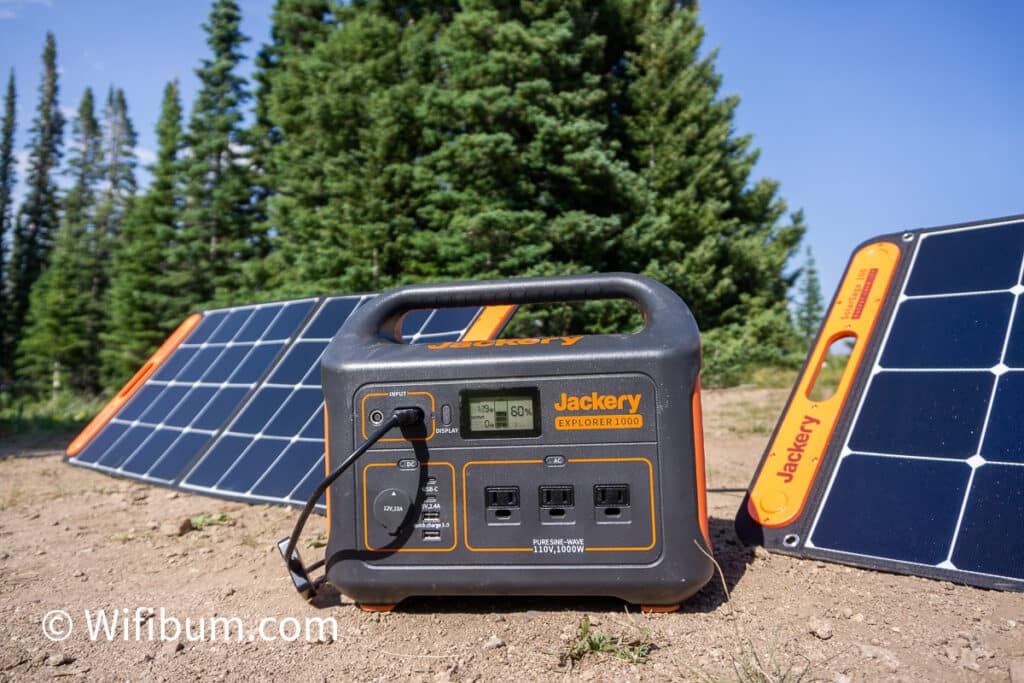
Price and Warranty

Look, portable power stations aren’t penny candy.
They’re an investment. While it’s tempting to opt for the cheapest, remember: quality often correlates with price.
Also, peek at the warranty. A solid guarantee often indicates the manufacturer’s confidence in their product. Your wallet will thank you in the long run.
Advanced Features
While the basics are essential, let’s not forget the bells and whistles.

Some power stations come with wireless connectivity, Bluetooth controls, and even app integration. Want to check your battery level from your phone? Or maybe have a system that optimizes power distribution? If you’re into techy perks, keep an eye out for these.
How Portable Power Stations are Tested
I often get asked, “How do I test these power stations?”
The answer?
Through real-life, hands-on experience.

While I might not have a lab filled with high-tech equipment, I’ve got something many don’t: actual day-to-day experience using these power stations in diverse situations.
Unlike many out there, I don’t accept freebies or discounted products. Why? Because it ensures that I’m giving you genuine recommendations. Sure, I could drop $50,000+ on every model and run them through a barrage of tests. But let’s be honest: many sites claiming exhaustive tests often have those units gifted to them, potentially influencing their rankings anyway.

Why Trust Me?
I’ve worked remotely since 2017, from campsites, SUVs, and Airbnbs. Throughout, knowing the best portable power stations has been crucial. My continuous search for the best options led to this article.
Drawing from years of use, research, and user data, this guide presents the top portable power stations on the market. Whether you’re an adventurer, prepper, or seeking reliable backup power, this article has the answers.
Instead, I recommend only trustworthy power station brands known for their LiFePO4 power stations. By doing so, I ensure quality and longevity right off the bat. Then, it’s all about breaking down the numbers—like cost per capacity—to give you a fair comparison.
But that’s not all.
My Proprietary Power Station Comparison Tool (Web App)
I’ve channeled hours of research into my proprietary tool, Power Station Finder Pro, a web app designed to guide users to their ideal portable power station.
It’s a tool built for clarity and objectivity, helping you cut through the noise and make informed decisions.

Portable Power Stations Trends 2023 and Beyond
As we surge forward into 2023, the world of portable power stations isn’t staying stagnant. Based on my continuous search and interaction with these devices, two major trends are starting to reshape the landscape:

LiFePO4 Batteries
Power station batteries are shifting from Nickel Manganese Cobalt (NMC) to Lithium Iron Phosphate (LiFePO4) batteries is more than just a mouthful of chemical terms.
It’s a game-changer.
LiFePO4 batteries boast several advantages over their NMC counterparts. They’re more thermally stable, which means they’re generally safer and have a lower risk of overheating. Plus, they offer longer lifespans, often resulting in more charge cycles. For consumers, this means batteries that not only last longer but are also more reliable in the long run.
Embrace of Wireless and Bluetooth Connectivity
We live in a connected world, and portable power stations are jumping on that bandwagon. The inclusion of wireless and Bluetooth features on power stations are becoming more common. With these features, users can monitor battery levels, control outputs, and even update the firmware of their power station directly from their smartphones or tablets. It’s all about making the user experience as seamless and integrated as possible.
Smart Power Management Systems
Some power stations now include intelligent power management systems. These systems optimize power distribution, ensuring efficient energy usage and prolonging battery life.
Expandable Portable Power Systems
A modular approach where users can add additional battery units or solar panels to expand their power or charging capabilities is becoming more prevalent. This trend offers users flexibility, especially beneficial for those with varying power needs.
Portable Power Station FAQs

How many years do portable power stations last?
The lifespan of portable power stations varies, typically lasting between 3 to 10 years. Factors such as battery type, usage frequency, and maintenance significantly affect their longevity. It’s essential to check the manufacturer’s specifications and warranty for a more precise duration.
My Jackery Explorer 1000 is 3+ years old and runs smoothly, holds charges when not in use, and seems to have the same capacity as it did when I purchased it.
What devices can I charge with a portable power station?
Portable power stations are versatile, capable of charging devices ranging from smartphones, laptops, and cameras to more power-hungry appliances like electric grills and TVs. The exact devices you can charge depend on the station’s capacity and output specifications.
Can a portable power station power household appliances, like a refrigerator?
Yes, a portable power station can power household appliances, including a refrigerator. I wrote specifically on this topic in my article Best Power Station for Refrigerators.
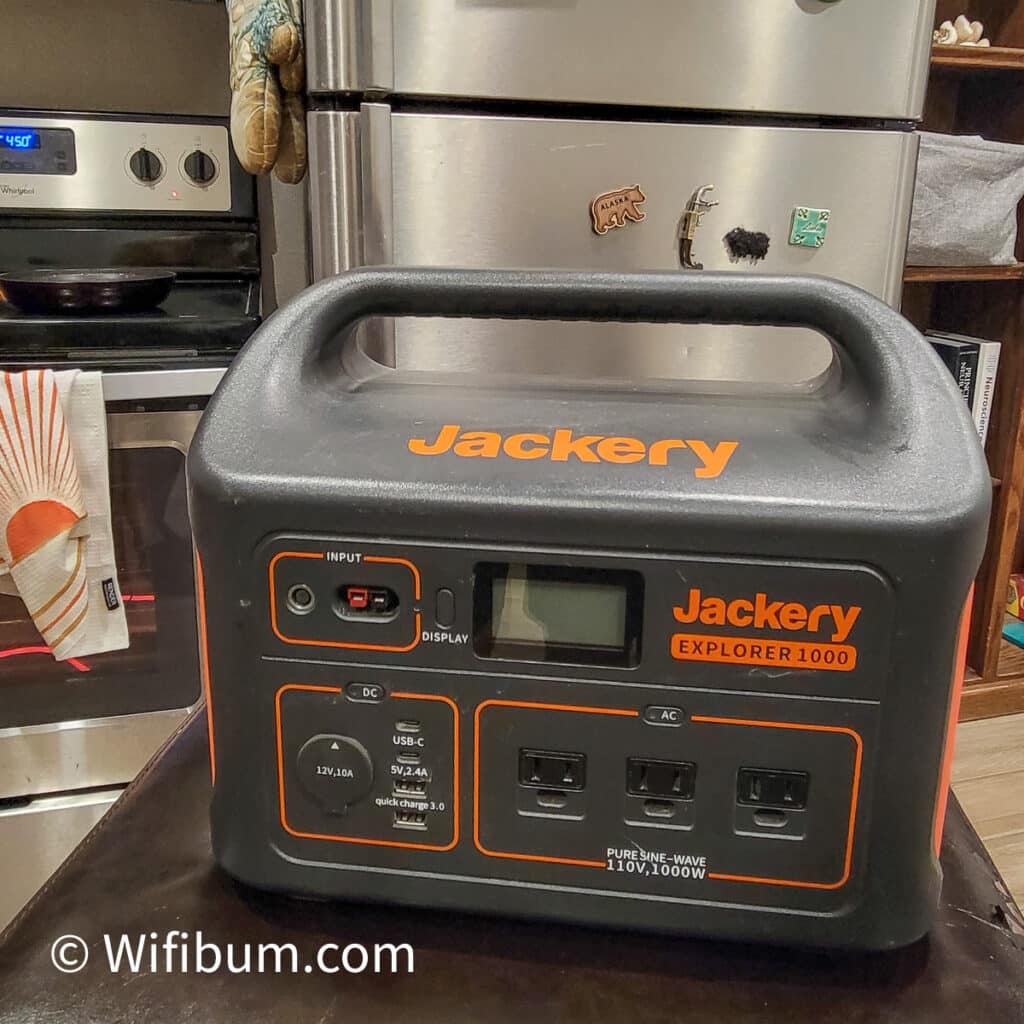
How does a portable power station differ from a traditional gas generator?
Portable power stations store electricity from the grid or renewable sources and dispense it when needed, whereas traditional gas/dieselgenerators produce electricity by burning fuel. As a result, power stations are quieter, eco-friendly, and don’t emit harmful gases, making them suitable for indoor use.
Are portable power stations safe to use indoors?
Yes, portable power stations are designed to be safe for indoor use. Unlike traditional generators, they don’t produce carbon monoxide or other harmful emissions. However, it’s essential to ensure proper ventilation and keep them away from flammable materials. It’s best to keep them out of hot cars for expended periods of time.
How do I maintain my portable power station to ensure longevity?
To maximize the lifespan of your power station:
- Keep it in a cool, dry place.
- Charge it every 3-6 months if not in regular use.
- Avoid draining the battery entirely; try to keep it above 20%.
- Clean the ports and exterior with a soft cloth periodically.
What’s the difference between LiFePO4 and NMC batteries in power stations?
LiFePO4 (Lithium Iron Phosphate) batteries are known for their longevity and safety, making them ideal for high-capacity power stations. NMC (Nickel Manganese Cobalt) batteries, on the other hand, often provide higher energy density but may have a shorter lifespan. Your choice depends on your usage needs and budget, but typically LiFePO4 power stations are the better option.
Can I charge a portable power station using solar panels?
Absolutely! Many portable power stations are designed to be solar-compatible, allowing for eco-friendly charging. The charging speed will depend on the power station’s input capacity and the solar panel’s efficiency. Ensure you have the right connectors and solar panels recommended by the power station manufacturer.
Final Thoughts
Buying the best portable power station can be boiled down to this:
- Buy from a reputable brand
- When in doubt, buy LiFePO4 portable power stations
Here is a power station spreadsheet I created to help show you the best prices.
| Brand | Power Station | Size (Wh) | Amazon | Amazon | Price per Wh | Direct | With Discount | Price per Wh |
|---|---|---|---|---|---|---|---|---|
| EcoFlow | River 2 | 256 | Amazon | $189.00 | $0.74 | EcoFlow.com | $198.55 | $0.78 |
| Anker | PowerHouse 521 | 256 | Amazon | $219.00 | $0.86 | Anker.com | $197.99 | $0.77 |
| Bluetti | EB3A | 268 | Amazon | $209.00 | $0.78 | Bluetti.com | $202.73 | $0.76 |
| EcoFlow | River 2 Max | 512 | Amazon | $379.00 | $0.74 | EcoFlow.com | $379.05 | $0.74 |
| Anker | PowerHouse 535 | 512 | Amazon | $499.00 | $0.97 | Anker.com | $449.99 | $0.88 |
| Bluetti | EB55 | 537 | Amazon | $399.00 | $0.74 | Bluetti.com | $387.03 | $0.72 |
| Bluetti | EB70S | 716 | Amazon | $499.00 | $0.70 | Bluetti.com | $484.03 | $0.68 |
| EcoFlow | River 2 Pro | 768 | Amazon | $499.00 | $0.65 | EcoFlow.com | $521.55 | $0.68 |
| EcoFlow | Delta 2 | 1024 | Amazon | $749.00 | $0.73 | EcoFlow.com | $949.05 | $0.93 |
| Anker | PowerHouse 555 | 1024 | Amazon | $899.98 | $0.88 | Anker.com | $809.98 | $0.79 |
| Bluetti | AC180 | 1152 | Amazon | $749.00 | $0.65 | Bluetti.com | $872.03 | $0.76 |
| Anker | SOLIX F1200 | 1229 | Amazon | $899.00 | $0.73 | Anker.com | $989.99 | $0.81 |
| EcoFlow | Delta 2 Max | 2048 | Amazon | $1,699.00 | $0.83 | EcoFlow.com | $1,519.05 | $0.74 |
| Anker | SOLIX F2000 | 2048 | Amazon | $1,798.00 | $0.88 | Anker.com | $1,439.10 | $0.70 |
| Bluetti | AC200P | 2048 | Amazon | $1,199.00 | $0.59 | Bluetti.com | $1,163.03 | $0.57 |
| Bluetti | AC200MAX | 2048 | Amazon | $1,599.00 | $0.78 | Bluetti.com | $1,551.03 | $0.76 |
| Jackery | Explorer 2000 Plus | 2048 | Amazon | $1,999.00 | $0.98 | Jackery.com | $1,979.10 | $0.97 |
| EcoFlow | Delta 2 Pro | 3600 | Amazon | $2,799.00 | $0.78 | EcoFlow.com | $3,039.05 | $0.84 |
| Anker | SOLIX F2000 w/ Expansion Battery | 4096 | Amazon | $2,799.00 | $0.68 | Anker.com | $2,339.10 | $0.57 |

